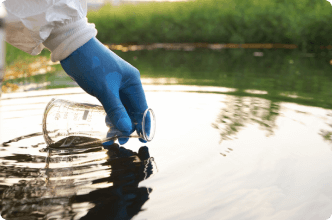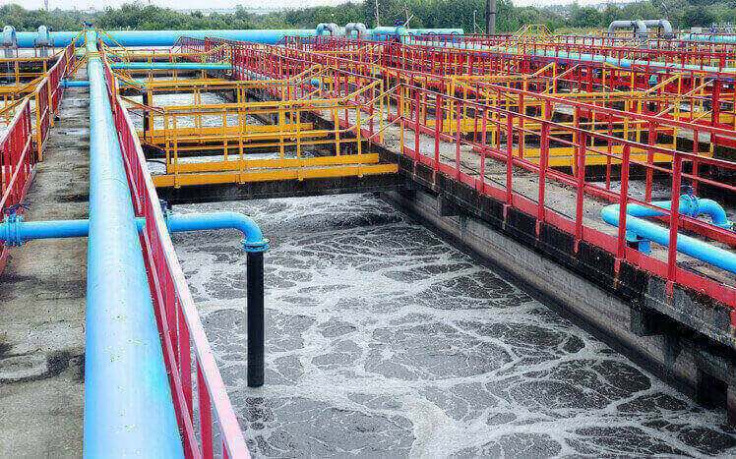Get Your Free Mesothelioma Guide

Find a Top Mesothelioma Doctor

Access Help Paying for Treatment

Asbestos can contaminate drinking water when old products age, decay or are damaged in storms, fires or other disasters. Materials in landfills or damaged buildings can leech asbestos fibers into groundwater. Water running through worn asbestos cement pipes can carry fibers through older homes.

Asbestos was widely used in water systems for most of the 20th century. These systems can crack and degrade over time, increasing the risk of asbestos contaminating the water supply.
At certain levels, asbestos in the water supply can pose a health risk to the general public. The World Health Organization says most U.S. residents drink water with low levels of asbestos. Water at these lower levels is unlikely to harm health.
Asbestos in Drinking Water
Suppliers must notify customers within 30 days if water contains high levels of asbestos. Knowing your risk and how to limit exposure from contaminated water can help you avoid the possible risk of lifelong health issues.
Asbestos is a known carcinogen. Inhalation of asbestos fibers is the primary cause of malignant mesothelioma. The toxic mineral is also linked to other asbestos-related diseases, including lung cancer.
Old, degrading asbestos cement pipes are a source of asbestos in drinking water. Approximately 12% to 15% of U.S. drinking water systems use asbestos cement pipes.
Asbestos cement pipes have an average lifespan of 70 years. Age, weather and damage can cause them to release asbestos fibers into the water moving through them.
Sources of Asbestos in Water
Runoff from mines and construction sites can contaminate soil. Improper industrial waste disposal can spread asbestos into the water supply. Some natural groundwater sources also contain asbestos.
Areas with a history of asbestos mining or manufacturing frequently have elevated levels of asbestos in the water. These locations typically also have high rates of soil contamination.
Landfills and construction sites often contain asbestos products. Consumers disposed of old home goods and toys that contained asbestos. Construction materials and industrial waste were often made with asbestos before the 1980s and were also disposed of in landfills. These asbestos materials contaminate soil and groundwater with asbestos.
Construction sites are also common sources of asbestos contamination. After natural disasters, cleanup teams often demolish buildings to remove debris. In cases like fires, hurricanes and tornadoes, exposed materials can be a problem. They might release asbestos fibers into water sources.
Legacy Asbestos Products In Landfills
Contractors removing asbestos concrete, for example, risk making it crumble if it’s brittle or damaged. Rainwater on asbestos roofs or pipes can pollute drinking water. As asbestos from these sites runs off, it can pollute rivers, streams and lakes, which can also contaminate drinking water.
Asbestos can also build up during landslides. For instance, the active and slow-moving Swift Creek Landslide in Washington carries asbestos fibers. This contaminates more than 120,000 cubic yards of sediment each year.
Get Your Free Mesothelioma Guide

Find a Top Mesothelioma Doctor

Access Help Paying for Treatment

Research presents conflicting results on the level of risk from drinking asbestos-contaminated water. However, the danger of inhaling asbestos is well understood. Water used on plants, clothes, dishes or general cleaning can leave asbestos fibers on surfaces. Once dry, these fibers can become airborne.
Long-term health risks from asbestos include asbestosis, mesothelioma, pleural plaques and lung cancer. In the short term, asbestos can contribute to respiratory irritation, pain and inflammation. There is no safe level of asbestos exposure.
Water treatment plants have several ways to detect and remove asbestos from drinking water. Coagulation and sedimentation, reverse osmosis and barrier filters, for example, can typically remove asbestos from the water supply.
The EPA monitors these methods. As a result of water treatment, most U.S. water supplies don’t contain toxic asbestos levels. However, some groups are at risk of 10 times the normal exposure amount. Natural erosion, mining, landfill issues or crumbling asbestos materials have heavily contaminated some areas.
Newer research is also experimenting with magnesium oxide and other filtration methods. These don’t produce as much sludge byproduct as chemical coagulation methods.
Several methods are used to treat water and minimize asbestos levels. Reverse osmosis is the top choice. It forces water through a semipermeable membrane that traps most contaminants. Water treatment systems using 1 micron or smaller reverse osmosis filters can eliminate the vast majority of asbestos in water.
Advanced water treatment plants can filter out 99.99% of asbestos fibers using granular media. Yet, they must manage pH with precision and conduct a thorough check of cloudiness or turbidity.
The EPA recommends a diatomaceous earth filter coated with aluminum hydroxide (often used in antacid medications). The agency advises it be set at 0.10 NTU water turbidity to achieve very clear water, removing asbestos from the water.

Federal and state rules govern maximum asbestos contamination levels, testing requirements and reporting protocols. The Safe Drinking Water Act of 1974 positions the EPA as the federal agency to regulate drinking water.
This act allows states to establish their own drinking water standards. State standards must meet or exceed the EPA’s standards for reducing potential asbestos exposure in home water supplies.
Federal groundwater regulations require suppliers to monitor for chemical compounds including asbestos in water. The EPA requires asbestos fibers longer than 10 micrometers to be below 7 million fibers per liter.
“Many scientists believe that there should be no threshold for the concentration of this contaminant, since the presence of a single fiber creates risk.”
The EPA established Enhanced Management Practices to stop asbestos release during building demolitions. These practices rely heavily on state and local rules for owners, operators, contractors and agencies. They call for safely removing accessible asbestos before demolition.
Safe asbestos removal uses water spray controls to reduce dust spread. However, this water can spread to other areas causing soil contamination. The National Pollutant Discharge Elimination System Construction Stormwater program teaches workers how to contain asbestos-contaminated water on site.
The EPA has pinpointed EMPs in key areas: Planning for resource allocation and policies for demolition and site cleanup. Before demolition, operators use a checklist to verify appropriate water management at the site. During demolition, special tools, such as barriers, covers and vacuum trucks, prevent asbestos from entering the surrounding environment.
Identifying the source of asbestos in your water is an important first step in assessing your risk and taking steps to protect your health. Never use cloudy, dark or odd-smelling water for drinking or cooking since it’s likely contaminated.
Tips for Reducing Exposure
When looking for a home water filtration system, reverse osmosis systems are often recommended. They can effectively remove asbestos from drinking water. However, whole house systems filter the water coming into your house. If the source of asbestos is old pipes within your home, you’ll need filters at the taps and may need to replace the pipes.
A trained and accredited asbestos abatement professional should remove asbestos cement pipes from your home. Safe asbestos removal is critical. Improper removal of asbestos products can create serious health risks. Asbestos fibers can become airborne and contaminate the air and surfaces in your home..
You can’t see asbestos in water. Asbestos fibers are microscopic. Most community water suppliers must test for asbestos and other contaminants and notify consumers of elevated levels. If you have public water, you can contact your provider and ask for a copy of the most recent test results.
Households with well water must perform their own tests. There are a few specialized at-home asbestos water testing kits. It’s a good idea to have professional testing done because of the precise methods used to identify asbestos in water.
There’s some conflicting information online about how people in the U.S. should report asbestos in drinking water. The Mesothelioma Center did some checking and spoke with a representative at an EPA hotline to confirm.
The EPA has several dedicated hotlines specifically for more information about asbestos and to connect to resources. The representative we spoke with confirmed reports of asbestos in drinking water are typically handled at the state level, but people can also call the EPA’s Asbestos Ombudsman Hotline to register a report at the federal level.
Contacting the Asbestos Ombudsman Hotline
The Asbestos Ombudsman Hotline receives asbestos-related complaints and provides assistance to the public as the Asbestos Hazard Emergency Response Act of 1986 requires. A member of the EPA Asbestos and Small Business Ombudsman staff will answer your call. They’re there to help small businesses and the general public.
You can find information about water supply safety at the following:
CDC.gov: The Safe Water System
In general, research suggests that asbestos in water poses a significantly smaller risk than airborne exposure. However, several studies point to increases in gastrointestinal cancers.
Boiling water doesn’t remove asbestos from water. It evaporates some of the liquid, which can increase asbestos fiber concentrations.
You may be eligible for certain state, local or federal assistance programs to remove asbestos-containing pipes. The National Center for Healthy Housing is an excellent resource for finding available programs.
Stay up-to-date on treatment, research, clinical trials, doctors and survivors
The information on this website is proprietary and protected. It is not a substitute for professional medical advice, diagnosis or treatment. Any unauthorized or illegal use, copying or dissemination will be prosecuted. Please read our privacy policy and terms of service for more information about our website.
This website and its content may be deemed attorney advertising. Prior results do not predict a similar outcome.
The Mesothelioma Center’s claim as the most trusted resource is based on our more than 150 5-star Google and BBB reviews. Our organization also helps more than half of all mesothelioma patients annually diagnosed.
Your web browser is no longer supported by Microsoft. Update your browser for more security, speed and compatibility.
If you are looking for mesothelioma support, please contact our Patient Advocates at (855) 404-4592
The Mesothelioma Center at Asbestos.com has provided patients and their loved ones the most updated and reliable information on mesothelioma and asbestos exposure since 2006.
Our team of Patient Advocates includes a medical doctor, a registered nurse, health services administrators, veterans, VA-accredited Claims Agents, an oncology patient navigator and hospice care expert. Their combined expertise means we help any mesothelioma patient or loved one through every step of their cancer journey.
More than 30 contributors, including mesothelioma doctors, survivors, health care professionals and other experts, have peer-reviewed our website and written unique research-driven articles to ensure you get the highest-quality medical and health information.
My family has only the highest compliment for the assistance and support that we received from The Mesothelioma Center. This is a staff of compassionate and knowledgeable individuals who respect what your family is experiencing and who go the extra mile to make an unfortunate diagnosis less stressful. Information and assistance were provided by The Mesothelioma Center at no cost to our family.LashawnMesothelioma patient’s daughter


Marchese, S. (2025, August 18). Asbestos in Drinking Water. Asbestos.com. Retrieved December 18, 2025, from https://www.asbestos.com/exposure/water-supply/
Marchese, Sean. "Asbestos in Drinking Water." Asbestos.com, 18 Aug 2025, https://www.asbestos.com/exposure/water-supply/.
Marchese, Sean. "Asbestos in Drinking Water." Asbestos.com. Last modified August 18, 2025. https://www.asbestos.com/exposure/water-supply/.

Sean Marchese is a registered nurse with experience developing and managing respiratory oncology clinical trials and treatments. He has more than 10 years of clinical experience as a nurse in pain management, neurosurgery and clinical trials.
Our fact-checking process begins with a thorough review of all sources to ensure they are high quality. Then we cross-check the facts with original medical or scientific reports published by those sources, or we validate the facts with reputable news organizations, medical and scientific experts and other health experts. Each page includes all sources for full transparency.
Please read our editorial guidelines to learn more about our content creation and review process.
